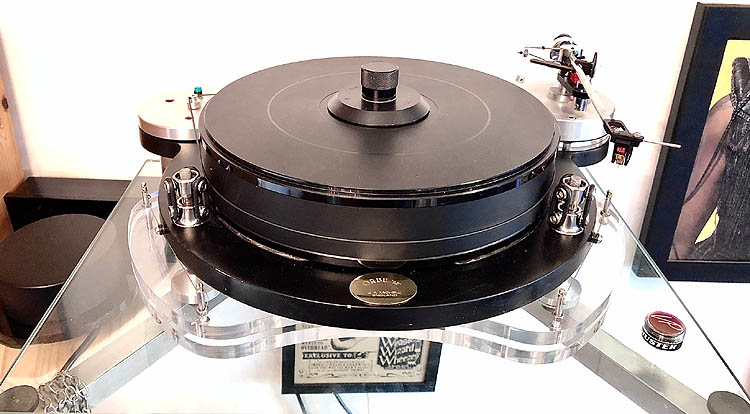
[ Home | Staff & Contacts | HiFi Playground | Listening tests | DIY & Tweakings | Music & Books ]

Product: Turntable Modification service for Michell turntables
Manufacturer: Gert Pedersen - Denmark
Price: depends on model 1100€ as reviewed, includes two part Orbe SE new vestigal plinth layers and Pedersen armboard modification.
See Pedersen price menu but
YMMV
depending on what you want from armboard only 1080DKK~150€ (less 30€ for full kit owners), full chassis Orbe/Gyrodec 5100DKK-5300DKK~720€-745€ to complete kit for full Orbe SE/Gyro SE 5500DKK-6900DKK~775€-972€
Reviewer: Mark Wheeler - TNT UK
Reviewed: Winter 2019 - Spring 2020
There were some rumours online that Gert Pedersen is, or was, not doing the Gyrodec/Orbe modifications anymore. There was, years ago, a brief period when Gert experienced problems getting parts for the upgrades, and he started a waiting list for interested people. So the Gyrodec/Orbe modifications under review here are currently available. The price depends on what model of Michell Gyrodec, Michell Gyro SE, Michell Orbe or Michell Orbe SE the customer intends to modify. There is also an extra charge of 2000DKK if customers require the build to be undertaken by Gert Pedersen himself or by the purchaser.
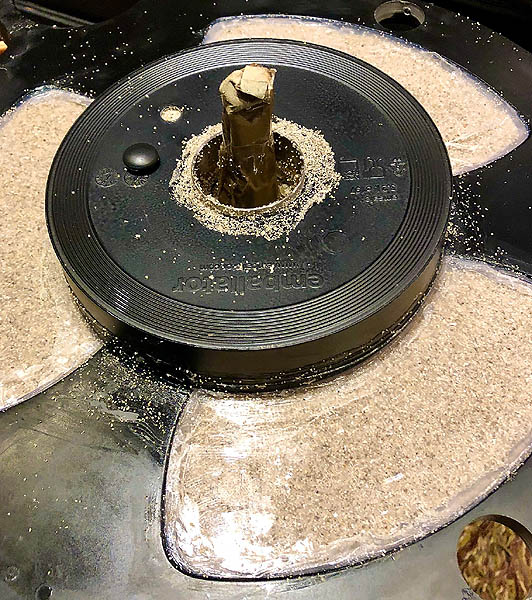
"The Old Scribe proposes carving open his own £3800 turntable and filling it with sand?" ask the Plebs' Chorus, stage left, incredulously, "The Old Scribe has finally taken leave of his senses"
So first we need to establish whether it is worth hacking into one of the best designed and well finished audio engineering products, drilling holes in it and slathering copious gobbits of bathroom silicon and kiln dried sand over it. Then we also need to consider whether it is worth the cost and whether it improves on the Gyrodec or Orbe strengths loved by the owner, or whether it changes the character of these turntables fundamentally.
Most comments on Gert Pedersen's website are about the bass, and the expectation set up by his audition instructions invite confirmation bias to affirm that, unquestioningly. However, your Old Scribe's first impression is cleaner, clearer midrange. Primarily this will probably be due to all the chassis stiffening and damping removing the well known Michell bloom.
Bass is indeed better articulated too. This might be because the improved midrange clarity is affecting the harmonics of bass notes, or because the lowest frequencies are better extended with an overall flatter frequency response. This will only become apparent through extended listening...
"As if the Old Scribe needs an excuse for more time in front of the Real Stereo!" sneer the Plebs' Chorus, stage left, somewhat rhetorically.
Is this a Logical Progression of the Orbe? Turning to the Blame project of Good Looking Records the Logical Progression series (Level 2) should sort out the bass from the bloat. A classic example is In The Area by ILS & Solo on side 1 of this classic post-jungle vinyl. There are a series of well sampled bass cadences which on many wide bandwidth systems sound as they would in a large club with a half-decent sound system.
Through a classic Linn/Naim active system (where two times two wrongs do actually make a right) these descents are perfect; it's like serialism meets drum'n'bass in the heart of the jungle. A properly set up (which is one of the two most important parts of this sentence) 1990 Linn Sondek LP12, will equal this for one octave of bass pitch. The properly set up Pedersen Orbe goes FURTHER (as the destination blind offers on the Electric Kool Aid Acid Test bus. Further and MUCH deeper.
TO set up THE Pedersen Orbe properly is ackshully a bigger challenge than properly setting up yer old Linn Sondek because there is an established custom & practice for Linn set up. The Pedersen Orbe is a one-off design so it demands several consecutive evenings of making it up as you go along expertise, despite the useful youtube videos.
Curiously, before the Pedersen Orbe was properly set up it was less coherent than a well chosen club Technics. Only after careful optimisation did the Pedersen Orbe SE eventually deliver the goods. It is worth investing as much time and effort as a conventionally suspended subchassis turntable to get the Pedersen Orbe tune playing.
Dynamic wow is audibly reduced with the Pedersen modifications, similarly to the Spoke Linn modification presumably because any reaction to stylus drag is tamed by the horizontal Kevlar links. Unipivot pickup arms, like the Hadcock GH242 SE Silver in use here, seem less prone to dynamic wow anyway, contributing to the success of the Naim Aro among those Linnies not desperate for exaggerated frequency extremes.
Bass note pitch is much more discernible post-Pedersen, for example Lee Sklaar's classic Snoopy's Search (on Billy Cobham's Spectrum LP) is much more explicit. To continue the LP12 comparisons in the language of the audio comics of that era, the Pedersen Orbe wipes floor with any pre Keel or Karousel Linn.
Surface noise (vinyl roar) seem increased on some pressings, via the Pedersen Orbe SE, which is surprising because chassis damping should help mitigate surface noise, especially when vinyl playback is considered in terms of the Boston-Dearborn analogy. However, this varies from pressing to pressing, some being improved. A copy of Zappa's Hot Rats bought used (from the excellent Cob records store in Porthmadog, in about '01, so already then 3 decades old) sounding as clean as ever.
Speaking of Zappa's Hot Rats, Paul Humphrey's contributions to Mr Green Genes and The Gumbo Variations time perfectly on the Pedersen Orbe SE, Humphries being a favourite percussionist since his Northern Soul anthem Cochise. Interplay with Max Bennet's bass rendered with exquisite clarity since Pedersonification.
However, all is neither perfect nor simple, in the Pedersen Orbe low frequencies. The midrange bloom is gone that the stock Orbe notoriously attaches to certain bass notes, a new peculiar emphasis seemed present on certain frequencies. After considerable experimentation and investigation the cause and solution were both identified. This deserves a whole article to itself (Part 4). At first this emphasis had the effect of tricking the ear into believing that the bass is epically extended and powerful (a similar trick pulled off by the aforementioned Linn Sondeks in their glory years) but this is ultimately misleading. Once corrected, the Pedersen Orbe low frequency response is tamed and genuinely extended further than the standard issue Orbe, which is already one of the best turntables in this respect.
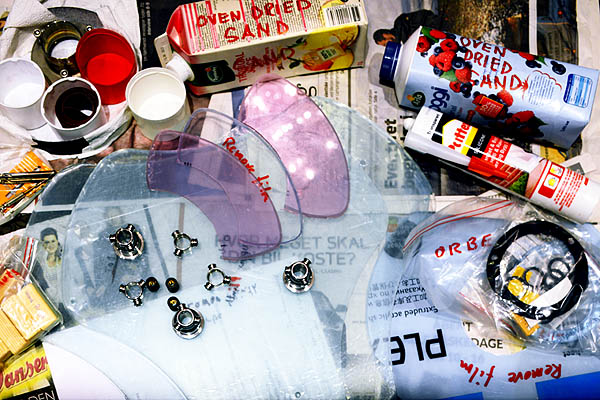
The Pederson Orbe/Gyro does take at least as much fettling and fine tuning as any sprung subchassis turntable, even though it is isolated by a fundamentally different mechanism from the dangly bouncy Michells and Logic DM101s of this world and it digresses even further from the compression suspended AR's, Thorens, Aristons and Linns. If it took Scottish engineering ingenuity over 2 decades to understand what's going on between some wood/mdf, 3 conical springs and some suspended metals, sufficient to make one that seldom needs readjustment, imagine the challenge presented by 9 O-rings and 6 lengths of Kevlar cord, all in various states of tension.
"WHAT ABOUT those 6 Kevlar cords that are working in 6 different vectors than the 9 O-rings?" enquire the Plebs' Chorus, stage left, suitably sceptically
Those aforementioned 6 Kevlar cords are indeed working in 6 different vectors from the 9 O-rings. Stick this on a turntable wall shelf with a tune-able horizontal mode and hours of 'fun' (or abject paranoia) are inevitable. The Origin Live Ultra wall shelf may be the best support for subchassis turntables ever conceived, but it adds its own set of horizontal tuning that makes perfect sense to optimise the Linn Sondek for which it was designed, but the Pedersen Orbe also has its own set of horizontal adjustments of all 6 Kevlar cord standards.
Surely the Origin Live shelf horizontal adjustment will interact which the Pedersen Kevlar cord adjustments and possibly set up either constructive or destructive interference?" demand Plebs, stage left, "Is it REALLY worth the effort?"
Never has turntable set up required such extensive use of test discs to identify performance traits, to establish what mechanism contributes to what sound effect and how to optimise the set up. There will need to be a whole article devoted to this aspect to ensure that any readers pursuing the Pedersen Journey to the Urge Within may get results as good as playing right now here. It is worth the effort.
During the set-up and review period the full range Hammer Dynamics 30cm driver in TQWP were alternating with the 3 way Focal Audiom active system. This emphasised the bass differences, but still the extra midrange clarity is the biggest musical win. As an old skool sound system builder, your Old Scribe is hyper-vigilant to bass quality and timing. The Pedersen mods do help to keep your bottom in shape and the biggest beneficiary of this is improved midrange clarity.
Initially another downside of the Pedersen Michell modifications seemed to be a perceived increase in rumble. Experiments show that this increased rumble is transmission of motor vibration. This will depend on users' turntable support surface material, but might be an inevitable consequence of short-circuiting one degree of isolation by replacing hanging springs with rubber O-rings and kevlar cords. The O-ring/suspended mass system resonates at a much higher frequency than the spring/suspended mass system and its vertical low-pass frequency is therefore much higher. This might affect motor noise transmission if motor noise is present at those affected frequencies.
Furthermore, the horizontal Kevlar cords are advised to be "tensioned like guitar strings" which is higher still at over 80Hz for low E, let alone any other strings which could be up to 330Hz with standard tunings. The standard Michell springs bounce below 10Hz and the Michell subchassis bloom is between 200Hz and 300Hz. Cartridges are designed to respond to horizontal (lateral) modulation (for all but spatial information which is the vertical vector) so this coincidence might have significant consequences. This can be effectively mitigated. The set-up article will address the problem and this listening test describes the fully optimised set up.
John Michell noted to your Old Scribe (in the early 90s while both were listening to a production ready prototype of the full fat Orbe) that the double chassis of Orbe is really significant at reducing motor vibration transmission. The Pedersen seems to lose some of that motor isolation. Therefore this might be even more detrimental to the Gyrodek single plinth. This could be addressed by further motor isolation, which will be considered in a future article. One answer for Orbe/Gyro SE owners is to try a more compliant motor mount than the Michell big O-ring on the bottom of the motor pod.
Motor noise breakthrough was tested by belt removal and stylus resting in a stationary groove. It is more noticeable at 45rpm than 33rpm. It is even more noticeable when the pulley is loaded by a belt at the correct tension (achieved with a Meccano pulley acting as an idler). This has now been fixed with a TNT variation on Gert Pederesen's original concept that might lift the performance of Gyro SE too. More on that one later.
Another change noticed pre & post Pedersonification is that my Orbe SE is now running about 0.8% faster than it was before. My Orbe SE was already running 0.5% fast before, due to lubrication experiments and was not yet adjusted. The sum of these speed errors is noticeable, so motor supply adjustment became necessary. The previous speed error had begun when experimenting with ultra-low friction lubricants and arises because the Michell power supply does not reference the speed to platter rotation but to pulley rotation and the limited friction between belt and motor pulley (as the belt stretches around the pulley) means that it could be behaving as a thicker belt when pulling against less friction.
Once set up correctly it was a pleasure just listening to vinyl. Another Zappa slab of vinyl, the Mothers of Invention Weasels Ripped My Flesh" was even-handedly presented despite being a compilation from different recordings in different venues. The impression is of thorough information retrieval without undue emphasis foregrounding anything. Your Old Scribe first heard this material live, then on a friend's Transcriptor Reference/SME3009/Shure V15iii before hearing it on every system ever to pass through the portals of the Old Scribe mountaintop lair. Sounding slightly less upfront than a Linn/Naim active predecessor, But equally engaging and secure sounding, which is why the Decca London will be worth a spin, in a follow up audition.
Despite the presence of Lowell George singing and the Neon Park sleeve Weasels Ripped My Flesh, following it onto the massive Orbe platter was not Little Feat but The Grateful Dead Blues for Allah. Possibly the Dead's funkiest offering, rhythm and timing are spot on. While the horizontal ties might be expected to improve dynamic wow performance over the stock Orbe SE, properly set up, the Orbe is no slouch. The Pedersen kevlar ties do not work like the Audio Files Spoke modification. The coil springs of the post Acoustic Research XA suspended subchassis turntables already (when correctly bouncing) tend toward a vertical movement (although this is only microns in practice) and the Spoke simply eliminates the last iota of precession. Pedersen's kevlar ties are the only mechanisms affecting horizontal movement as the O-rings allow far more pendulum action than vertical elasticity.
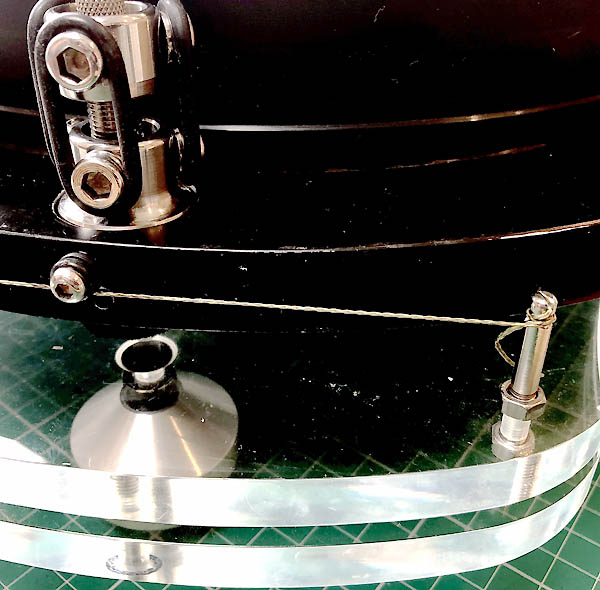
Before putting drill to Michell your Old Scribe and an audiophile engineer spent months contemplating the Pedersen parts and instructions. There is no money back guarantee (Gert Pedersen is a one man operation, making parts to order in his workshop in Denmark. There is no going back without buying a new Orbe or Gyrodek subchassis. It is very unlikely that anyone would wish to return their Michell turntable to standard specification, once the Pedersen modifications have been auditioned.
Two caveats do apply. It is probably better to start with a full plinth Orbe because the adaptation to the Spider Edition (SE) undermines its fundamental elegance and also reveals too much of the silicone & sand for most people's sensibilities. Similarly, the Gyrodek platter would both reveal, and draw attention to, the perspex, silicone, plastic pot and sand of the Pedersen subchassis arrangement.
The benefits of the Orbe extra motor isolation, better power supply and deep platter are substantially greater in themselves over the Gyrodec than the Pedersen modifications are above the Orbe. Therefore the money is better spent modifying an Orbe than a Gyrodec even though the kit was originally developed on the Gyro. The Orbe aesthetic is far better suited to the task. However, many Gyrodecs have been satisfactorily Pedersonified. The Pedersen website gallery illustrates many fine examples pleasing their proud owners.
Many years of intimate familiarity with the Michell Gyrodec, Gyro SE and the Michell Orbe SE lead to a secure recommendation to start with a full plinth Orbe before proceeding with the Pedersen modifications. The Orbe offers a substantially higher baseline, much lower bassline, and opens a wider window than the Gyrodec through which to benefit from the Pedersen sonic improvements. The full plinth version of the Michell Orbe does not require any new acrylic, as the Spider Edition does so this would be the recommended option.
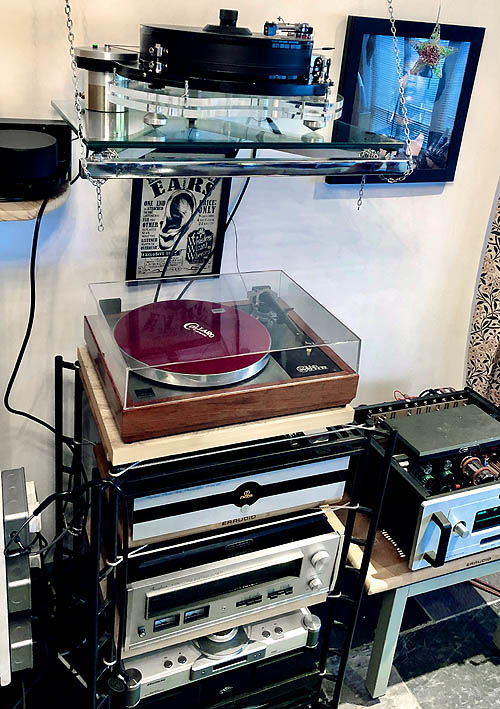
The Pedersen full modification package offers a worthwhile, significant improvement over the standard Michell Orbe. The Pedersen modifications do elevate the Michell Orbe to a higher performance league. The Michell Orbe plays in Britain's Turntable Premier League, the Pedersen Orbe is now in the Champion's League, with the addition of a Danish player. There's nowt got for nowt and quite apart from the price, there's a substantial amount of owner/installer drilling, tapping, gluing, funnelling, adjusting, tweaking, adapting and cussing.
Despite the Pedersen website testimonials emphasis on changes in bass quality after installing the Pedersen modifications, improvements are most noticeable higher up. In a truly high resolution wide bandwidth system, the most obvious long term differences are gained in the midrange. Clearer leading edges, less interference from bloom and improved bottom-to-top PRaT and better articulated note envelopes characterise the differences at least as much as the much vaunted tighter, deeper bass. That this is obvious with a unipivot arm Hadcock GH242 SE Silver) is a stronger endorsement, given that Gert Pedersen began this journey trying to address the problem of arm energy from SME Series V exciting too many resonances in the Gyrodec chassis.
The owner involvement adds to the delight in achieving an audible lift in performance to an already established high-end product. Michell had come a long way since their days of making Transcriptors turntables under licence and the Michell Orbe was John Michell's final foray into production turntable innovation. Gert Pedersen picked up his baton and has run with it in a slightly different direction. The full Pedersen modifications take the Michell Orbe forward in a slightly different direction from the Gyrodec to Orbe progression.
Starting from a much loved Michell Orbe owners who undertake the work themselves can revel in the excellent sound and the chance to say, "I built that turntable".
Fast forward to [Part II]
|
Music enjoyed while writing this review |
Reference system |
|---|---|
|
on vinyl of course
Test discs were used to set up, somewhat less enjoyably:
|
Equipment used in this review:
Donor Turntable: Michell Orbe SE Pick-up arm 1: HadcockGH242 SE with all silver wiring from cartridge to silver Eichmann Bullet plugs Some wire is used to join these components together. No interconnects cost more than 10% of the device at each end, much of it made by the Old Scribe from high quality components without Pixie Dust. Mark's amplifier-to-loudspeaker wire (full range, mid-range, tweeter) is ultra-low impedance Black Rhodium S900, a low-Z variation on the Black Rhodium S600 cable that came out well in Ben Duncan's objective and subjective correlation tests, selected primarily to match the OPT/driver damping factor, not for any magical qualities. Bass only loudspeaker cable Naim NACA 5, which remains unchallenged below 350Hz. Mains is supplied by an audio only ring main with Radex earth (ground) non-inductive connections and a technical earth. Crossover and power ampliers fed by a minimum connections hydra, sources and pre-amp from terminal blocks within the audio only ring. |
DISCLAIMER. TNT-Audio is a 100% independent magazine that neither accepts advertising from companies nor requires readers to register or pay for subscriptions. After publication of reviews, the authors do not retain samples other than on long-term loan for further evaluation or comparison with later-received gear. Hence, all contents are written free of any “editorial” or “advertising” influence, and all reviews in this publication, positive or negative, reflect the independent opinions of their respective authors. TNT-Audio will publish all manufacturer responses, subject to the reviewer's right to reply in turn.
Copyright © 2020 Mark Wheeler - mark@tnt-audio.com - www.tnt-audio.com
[ Home | Staff & Contacts | HiFi Playground | Listening tests | DIY & Tweakings | Music & Books ]